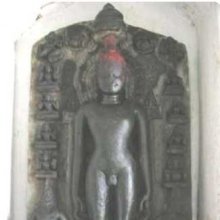Nasik, Nāsik: 4 definitions
Introduction:
Nasik means something in the history of ancient India, biology. If you want to know the exact meaning, history, etymology or English translation of this term then check out the descriptions on this page. Add your comment or reference to a book if you want to contribute to this summary article.
Images (photo gallery)
India history and geography
Source: What is India: Annual Report on Indian Epigraphy (1945-1952)Nāsik is an archaeologically important site situated in Nasik district, known for inscriptions regarding the ancient history of India. For example, at Nāsik there are various caves which contains Prakrit inscriptions in Brāhmī script. One such inscription belongs to king Vāsiṭhiputa Siri-Pulumayi of the Śātavāhana dynasty and is dated Śaka 1176.
Source: Singhi Jain Series: Ratnaprabha-suri’s Kuvalayamala-katha (history)Nasik (identified with Godāvarī) is the name of a country included in an international list of students participating in universities of ancient India, as depicted in the Kathās (narrative poems) such as Uddyotanasūri in his 8th-century Kuvalayamālā (a Prakrit Campū, similar to Kāvya poetry).—Page 150.17 f. & 151.1-5: There is described an educational institution which included students from [e.g., Godāvarī/Nasik] [...]. The courses of study comprised Vyākaraṇa, Buddhism, Sāṃkhya, Nyāya, Anekānta or Jaina and Lokāyata or Cārvāka philosophies. At another place (151.6-11) the prince came across persons who cultivated the seventy-two arts and sixty-four sciences, [...].

The history of India traces the identification of countries, villages, towns and other regions of India, as well as mythology, zoology, royal dynasties, rulers, tribes, local festivities and traditions and regional languages. Ancient India enjoyed religious freedom and encourages the path of Dharma, a concept common to Buddhism, Hinduism, and Jainism.
Biology (plants and animals)
Source: Wisdom Library: Local Names of Plants and DrugsNasik [নসিক] in the Manipuri language is the name of a plant identified with Corymbia citriodora from the Myrtaceae (Bottlebrush) family having the following synonyms: Eucalyptus citriodora. For the possible medicinal usage of nasik, you can check this page for potential sources and references, although be aware that any some or none of the side-effects may not be mentioned here, wether they be harmful or beneficial to health.
Source: Google Books: CRC World Dictionary (Regional names)1) Nasik in India is the name of a plant defined with Corymbia citriodora in various botanical sources. This page contains potential references in Ayurveda, modern medicine, and other folk traditions or local practices It has the synonym Eucalyptus variegata F. Muell. (among others).
2) Nasik is also identified with Eucalyptus globulus It has the synonym Eucalyptus maidenii subsp. globulus (Labill.) J.B. Kirkp..
Example references for further research on medicinal uses or toxicity (see latin names for full list):
· Journal of an Expedition into the Interior of Tropical Australia (1848)
· Austral. Syst. Bot. (2000)
· Journal of Ethnopharmacology (2002)
· Bot. Journal of the Linnean Society (1975)
· Journal de Botanique Société de Botanique de France (2004)
· Austrobaileya (2000)
If you are looking for specific details regarding Nasik, for example chemical composition, side effects, extract dosage, health benefits, diet and recipes, pregnancy safety, have a look at these references.

This sections includes definitions from the five kingdoms of living things: Animals, Plants, Fungi, Protists and Monera. It will include both the official binomial nomenclature (scientific names usually in Latin) as well as regional spellings and variants.
See also (Relevant definitions)
Starts with (+32): Nacikai, Nacikakkiram, Nacikamalam, Nacikaparanam, Nacikapitam, Nacikapushani, Nacikarokam, Nacikattu, Naciketan, Nacikkanappu, Nashikakara, Nasika, Nasikabharana, Nasikacchinni, Nasikachidra, Nasikachinni, Nasikacurna, Nasikadvara, Nasikagra, Nasikagratas.
Ends with: Annunasik, Anunasik, Niranunasik, Putat nasik, Sanunasik.
Full-text (+54): Godavari, Pancavati, Nasika, Putat nasik, Kapaleshvara, Abhinavanarayanacampu, Asthivilayatirtha, Trirashmi, Kekapura, Agastyashrama, Nasikya, Kapura, Lohanagara, Cakoraparvata, Nigamasabha, Paradhida, Haribhaskara, Mandala, Southern India, Vatanagara.
Relevant text
Search found 34 books and stories containing Nasik, Nāsik; (plurals include: Nasiks, Nāsiks). You can also click to the full overview containing English textual excerpts. Below are direct links for the most relevant articles:
Impact of Vedic Culture on Society (by Kaushik Acharya)
Sanskrit Inscriptions (G): The Cālukyas < [Chapter 3]
Sanskrit Inscriptions (D): The Kaṭāccuris / Early Kalācuris < [Chapter 3]
Chart: Movement of Vedic Brāhmaṇas < [Chapter 3]
Amaravati Art in the Context of Andhra Archaeology (by Sreyashi Ray chowdhuri)
Resemblance to Deccan art < [Chapter 5 - Impact of Amarāvatī Art]
The rule of the Sātavāhanas < [Chapter 4 - Survival of Amarāvatī in the Context of Andhra Art]
Trading routes of Amarāvatī-Dhānyakaṭaka < [Chapter 4 - Survival of Amarāvatī in the Context of Andhra Art]
Jainism in Odisha (Orissa) (by Ashis Ranjan Sahoo)
Santinatha image at Khandeswara Temple, Nasik < [Chapter 3: Survey of Jaina Antiquities in Odisha]
Jaina Antiquities in Jagatsinghpur District (Introduction) < [Chapter 3: Survey of Jaina Antiquities in Odisha]
Archaeological importance of Nasik, Jagatsinghpur < [Chapter 3: Survey of Jaina Antiquities in Odisha]
Buddhist records of the Western world (Xuanzang) (by Samuel Beal)
Chapter 11 - Country of Kiu-che-lo (Gurjara) < [Book XI - Twenty-three Countries]
Chapter 13 - Country of ’An-ta-lo (Andhra) < [Book X - Seventeen Countries]
Matangalila and Hastyayurveda (study) (by Chandrima Das)
Related products

